warning Abarth 500 2016 Owner handbook (in English)
[x] Cancel search | Manufacturer: ABARTH, Model Year: 2016, Model line: 500, Model: Abarth 500 2016Pages: 215, PDF Size: 19.08 MB
Page 101 of 215

Warning lights on
displayWhat it means What to do
amberEXTERIOR LIGHTS FAILURE
On some versions, the display will show the
symbol and a dedicated message if a fault is
detected in one of the following lights:
❒daytime running lights (DRL)
❒side lights
❒direction indicators
❒rear fog light
❒number plate lights.The fault may be caused by a blown bulb, a
blown protective fuse or a break in the electrical
connection.
amberASR SYSTEM
The symbol on the display flashes to indicate the
intervention of the ASR system.
amberPOSSIBLE ICE ON ROAD
The symbol is displayed when the outside
temperature falls to or below 3°C.
The display shows the dedicated message.
amberBRAKE LIGHT FAILURE
The display will show the symbol together with a
dedicated message if there is a fault in the brake
lights.
amberPARKING SENSOR FAILURE
The symbol is shown on the display together with
a dedicated message if there is a fault in the
parking sensors.
97
Page 102 of 215

Warning lights on
displayWhat it means What to do
amberiTPMS
(for versions/markets, where provided)
When the key is turned to MAR-ON, the warning
light switches on but it should switch off after a
few seconds.IMPORTANT Do not continue driving with one or
more flat tyres as handling may be compromised.
Stop the vehicle, avoiding sharp braking and
steering.
Low tyre pressure
The warning light switches to indicate that the
pressure of one or more tyres is lower than the
recommended value, in order to guarantee long
tyre life and low fuel consumption, or to indicate a
slow loss of pressure.
In this way the iTPMS warns the driver that one or
more tyres may be flat and probably punctured.In this case it is advisable to restore the correct
pressure value (see the "Wheels" paragraph in the
"Technical specifications" section).
Once the normal operating conditions of the
vehicle are restored, carry out the Reset
procedure.
iTPMS failure/iTPMS temporarily deactivated
The warning light flashes for about 75 seconds
and then stays on constantly (together with a
message on the display) (see “Operating
conditions” paragraph) to indicate that the system
is temporarily deactivated or faulty.
The system goes back to normal operation when
the operating conditions allow it. If this is not the
case, carry out the Reset procedure after
restoring the normal operating conditions.If the malfunction warning persists, contact an
Abarth Dealership as soon as possible.
98
KNOWING THE INSTRUMENT PANEL
Page 103 of 215

Warning lights on
displayWhat it means What to do
amberSERVICE (SCHEDULED SERVICING)
The symbol is shown on the display together with
a dedicated message, with key at MAR-ON,
2,000 km (or equivalent value in miles) before the
following scheduled servicing interval and is
activated again every 200 km (or equivalent value
in miles).Go to an Abarth Dealership, where the operations
of the "Scheduled Servicing Plan" will be
performed and the message will be reset.
whiteSPEED LIMIT EXCEEDED
(for versions/markets, where provided)
When the car exceeds the speed limit set in the
Setup menu (e.g. 120 km/h), a message and a
dedicated symbol are shown on the display.
ENGAGEMENT OF SPORT FUNCTION
The SPORT indication is shown on the analogue
pressure gauge and the instrument panel shows
a dedicated screen when the "SPORT" function is
engaged by pressing the relevant button on the
dashboard (see the "Controls" paragraph in the
"Knowing your car" chapter). The indication
SPORT will switch off when the button is pressed
again.
99
Page 104 of 215
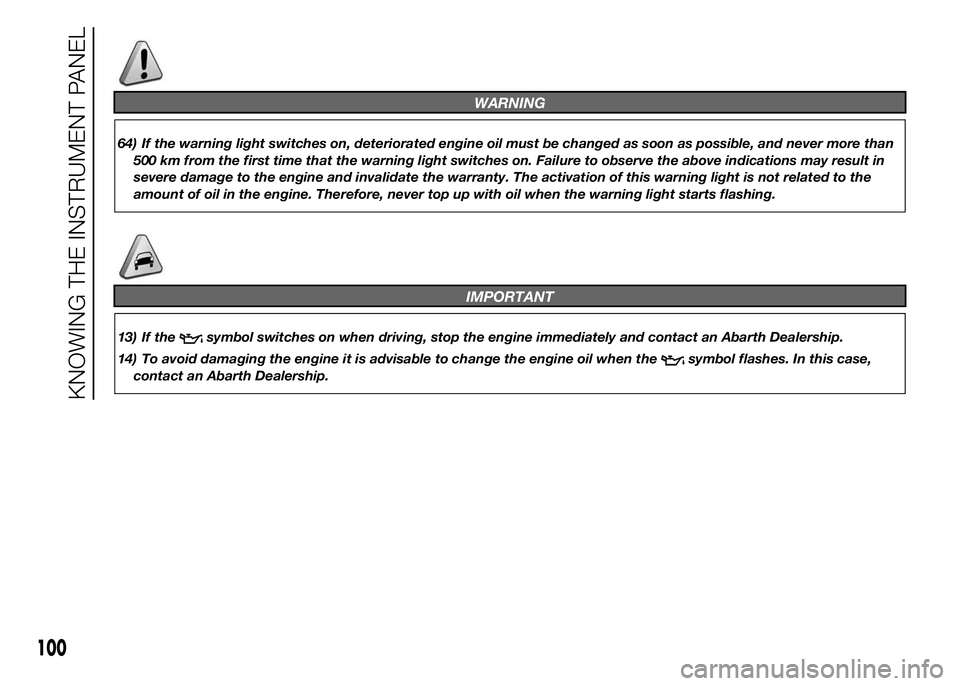
WARNING
64) If the warning light switches on, deteriorated engine oil must be changed as soon as possible, and never more than
500 km from the first time that the warning light switches on. Failure to observe the above indications may result in
severe damage to the engine and invalidate the warranty. The activation of this warning light is not related to the
amount of oil in the engine. Therefore, never top up with oil when the warning light starts flashing.
IMPORTANT
13) If thesymbol switches on when driving, stop the engine immediately and contact an Abarth Dealership.
14) To avoid damaging the engine it is advisable to change the engine oil when the
symbol flashes. In this case,
contact an Abarth Dealership.
100
KNOWING THE INSTRUMENT PANEL
Page 106 of 215

SEAT BELTS
USING THE SEAT BELTS
The belt should be worn keeping the
torso straight and rested against the
backrest.
To fasten the seat belts, hold the
tongue A fig. 75 and insert it into the
buckle B fig. 75, until it clicks into
place.
On removal, if the seat belt jams, let it
rewind for a short stretch, then pull
it out again without jerking.
Press button C fig. 75 to release the
belt.
Guide the belt while it is rewinding to
prevent it from twisting. Through the
retractor, the belt automatically adapts
to the body of the passenger wearing it,
allowing freedom of movement.The retractor may lock when the car is
parked on a steep slope: this is
perfectly normal. Furthermore, the
retractor mechanism locks the belt if it
is pulled sharply or in the event of
sudden braking, collisions or
high-speed bends.
65) 66)
The rear seat is fitted with inertia seat
belts with three anchor points and a
retractor.
WARNING
65) Do not press button C when
travelling.
66) Remember that in the event of
an accident, the rear seat
passengers not wearing seat belts
are exposed to a very serious
risk and also represent a serious
danger for the front seat
occupants.
SBR (Seat Belt
Reminder) SYSTEM
IN BRIEF
This system comprises an acoustic
warning which, in conjunction with
the
warning light flashing on the
instrument panel, advises the driver if
their seat belt has not been fastened.
For long-term deactivation of the
SBR system, contact an Abarth
Dealership.
The acoustic warning can be
reactivated at any time through the
Setup menu (see "Menu items"
paragraph in "Knowing the
instrument panel" chapter).
The system warns the driver and the
front passenger if their seat belt is
not fastened, as follows:
❒warning light
switched on
constantly and continuous acoustic
signal for the first 6 seconds;
❒warning light
flashing and
intermittent acoustic signal for the
first next 96 seconds.
75AB0A0059
102
SAFETY
Page 108 of 215
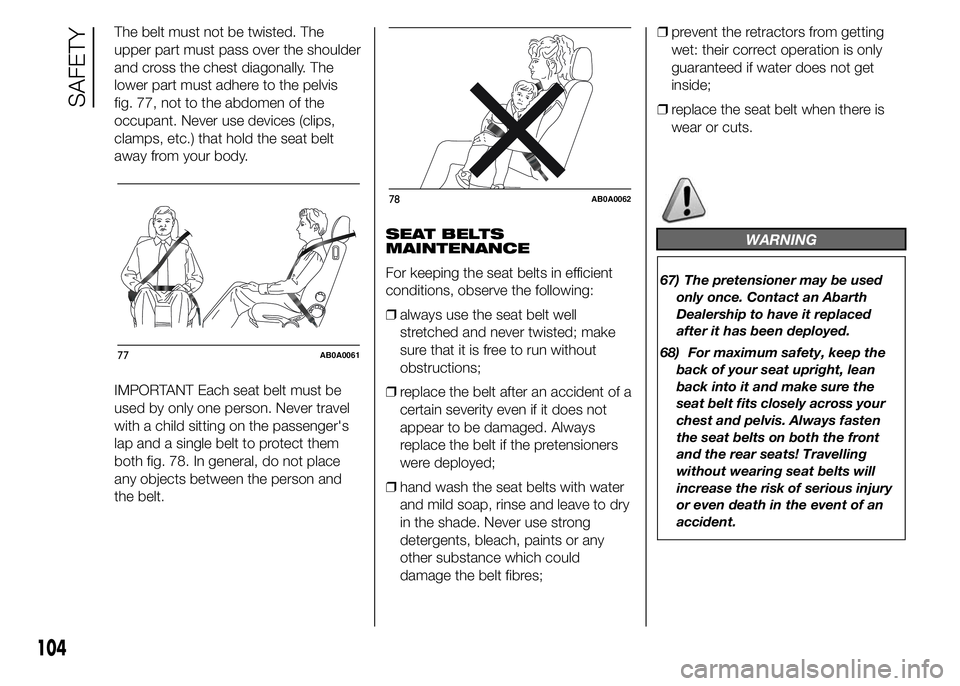
The belt must not be twisted. The
upper part must pass over the shoulder
and cross the chest diagonally. The
lower part must adhere to the pelvis
fig. 77, not to the abdomen of the
occupant. Never use devices (clips,
clamps, etc.) that hold the seat belt
away from your body.
IMPORTANT Each seat belt must be
used by only one person. Never travel
with a child sitting on the passenger's
lap and a single belt to protect them
both fig. 78. In general, do not place
any objects between the person and
the belt.SEAT BELTS
MAINTENANCE
For keeping the seat belts in efficient
conditions, observe the following:
❒always use the seat belt well
stretched and never twisted; make
sure that it is free to run without
obstructions;
❒replace the belt after an accident of a
certain severity even if it does not
appear to be damaged. Always
replace the belt if the pretensioners
were deployed;
❒hand wash the seat belts with water
and mild soap, rinse and leave to dry
in the shade. Never use strong
detergents, bleach, paints or any
other substance which could
damage the belt fibres;❒prevent the retractors from getting
wet: their correct operation is only
guaranteed if water does not get
inside;
❒replace the seat belt when there is
wear or cuts.
WARNING
67) The pretensioner may be used
only once. Contact an Abarth
Dealership to have it replaced
after it has been deployed.
68) For maximum safety, keep the
back of your seat upright, lean
back into it and make sure the
seat belt fits closely across your
chest and pelvis. Always fasten
the seat belts on both the front
and the rear seats! Travelling
without wearing seat belts will
increase the risk of serious injury
or even death in the event of an
accident.
77AB0A0061
78AB0A0062
104
SAFETY
Page 110 of 215
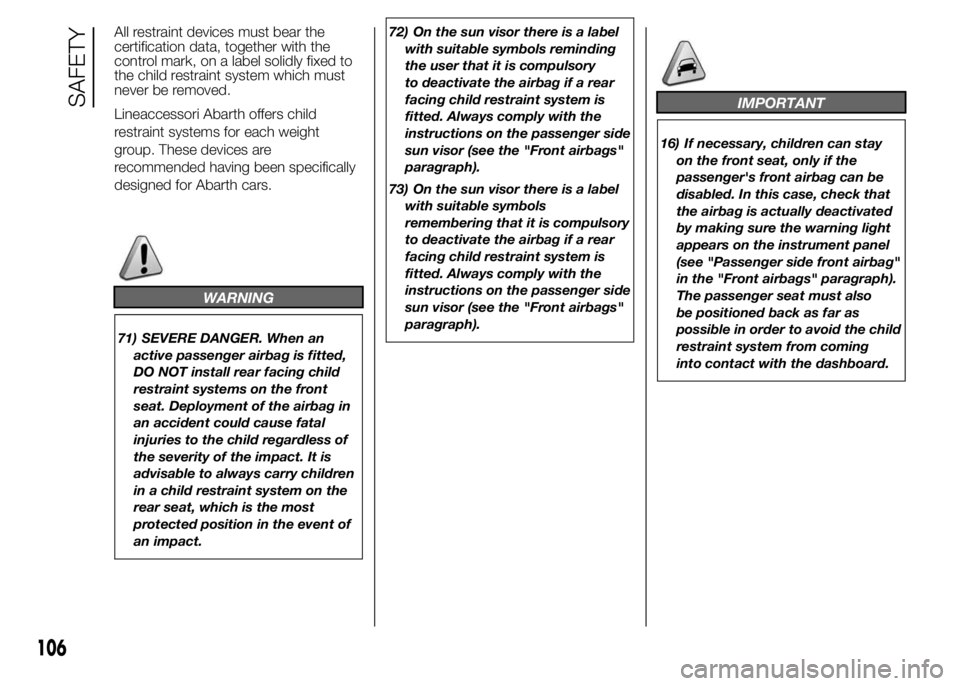
All restraint devices must bear the
certification data, together with the
control mark, on a label solidly fixed to
the child restraint system which must
never be removed.
Lineaccessori Abarth offers child
restraint systems for each weight
group. These devices are
recommended having been specifically
designed for Abarth cars.
WARNING
71) SEVERE DANGER. When an
active passenger airbag is fitted,
DO NOT install rear facing child
restraint systems on the front
seat. Deployment of the airbag in
an accident could cause fatal
injuries to the child regardless of
the severity of the impact. It is
advisable to always carry children
in a child restraint system on the
rear seat, which is the most
protected position in the event of
an impact.72) On the sun visor there is a label
with suitable symbols reminding
the user that it is compulsory
to deactivate the airbag if a rear
facing child restraint system is
fitted. Always comply with the
instructions on the passenger side
sun visor (see the "Front airbags"
paragraph).
73) On the sun visor there is a label
with suitable symbols
remembering that it is compulsory
to deactivate the airbag if a rear
facing child restraint system is
fitted. Always comply with the
instructions on the passenger side
sun visor (see the "Front airbags"
paragraph).
IMPORTANT
16) If necessary, children can stay
on the front seat, only if the
passenger's front airbag can be
disabled. In this case, check that
the airbag is actually deactivated
by making sure the warning light
appears on the instrument panel
(see "Passenger side front airbag"
in the "Front airbags" paragraph).
The passenger seat must also
be positioned back as far as
possible in order to avoid the child
restraint system from coming
into contact with the dashboard.
106
SAFETY
Page 112 of 215
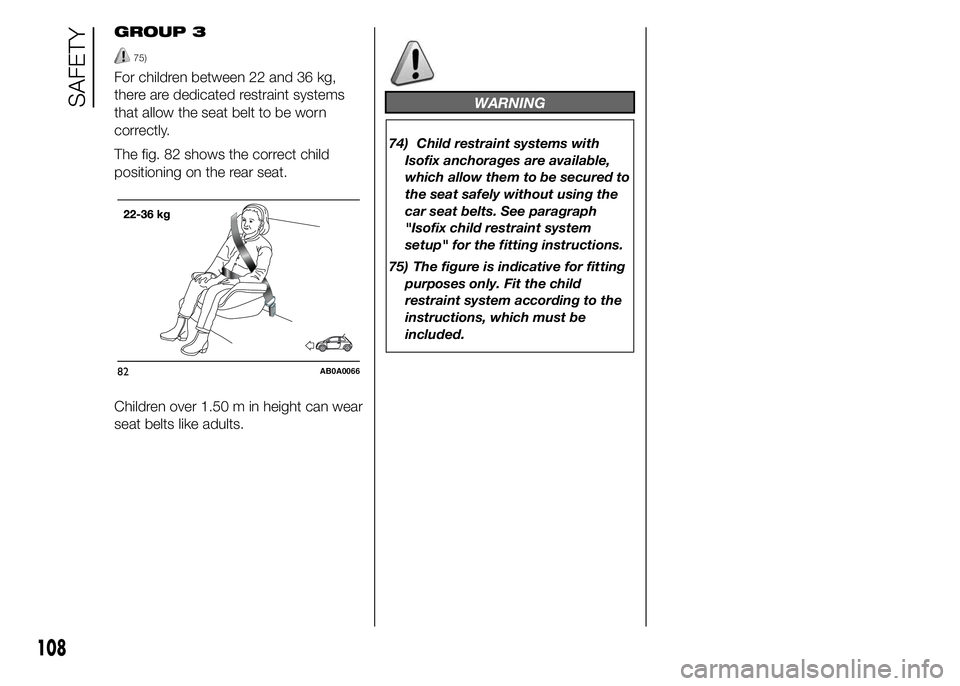
GROUP 3
75)
For children between 22 and 36 kg,
there are dedicated restraint systems
that allow the seat belt to be worn
correctly.
The fig. 82 shows the correct child
positioning on the rear seat.
Children over 1.50 m in height can wear
seat belts like adults.
WARNING
74) Child restraint systems with
Isofix anchorages are available,
which allow them to be secured to
the seat safely without using the
car seat belts. See paragraph
"Isofix child restraint system
setup" for the fitting instructions.
75) The figure is indicative for fitting
purposes only. Fit the child
restraint system according to the
instructions, which must be
included.
82AB0A0066
108
SAFETY
Page 117 of 215
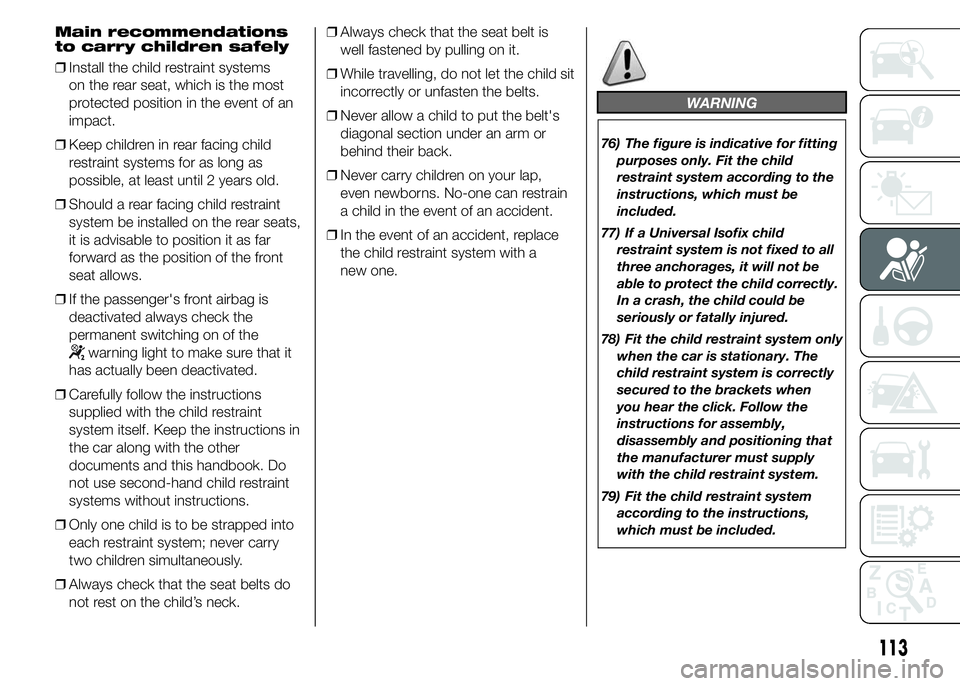
Main recommendations
to carry children safely
❒Install the child restraint systems
on the rear seat, which is the most
protected position in the event of an
impact.
❒Keep children in rear facing child
restraint systems for as long as
possible, at least until 2 years old.
❒Should a rear facing child restraint
system be installed on the rear seats,
it is advisable to position it as far
forward as the position of the front
seat allows.
❒If the passenger's front airbag is
deactivated always check the
permanent switching on of the
warning light to make sure that it
has actually been deactivated.
❒Carefully follow the instructions
supplied with the child restraint
system itself. Keep the instructions in
the car along with the other
documents and this handbook. Do
not use second-hand child restraint
systems without instructions.
❒Only one child is to be strapped into
each restraint system; never carry
two children simultaneously.
❒Always check that the seat belts do
not rest on the child’s neck.❒Always check that the seat belt is
well fastened by pulling on it.
❒While travelling, do not let the child sit
incorrectly or unfasten the belts.
❒Never allow a child to put the belt's
diagonal section under an arm or
behind their back.
❒Never carry children on your lap,
even newborns. No-one can restrain
a child in the event of an accident.
❒In the event of an accident, replace
the child restraint system with a
new one.
WARNING
76) The figure is indicative for fitting
purposes only. Fit the child
restraint system according to the
instructions, which must be
included.
77) If a Universal Isofix child
restraint system is not fixed to all
three anchorages, it will not be
able to protect the child correctly.
In a crash, the child could be
seriously or fatally injured.
78) Fit the child restraint system only
when the car is stationary. The
child restraint system is correctly
secured to the brackets when
you hear the click. Follow the
instructions for assembly,
disassembly and positioning that
the manufacturer must supply
with the child restraint system.
79) Fit the child restraint system
according to the instructions,
which must be included.
113
Page 119 of 215
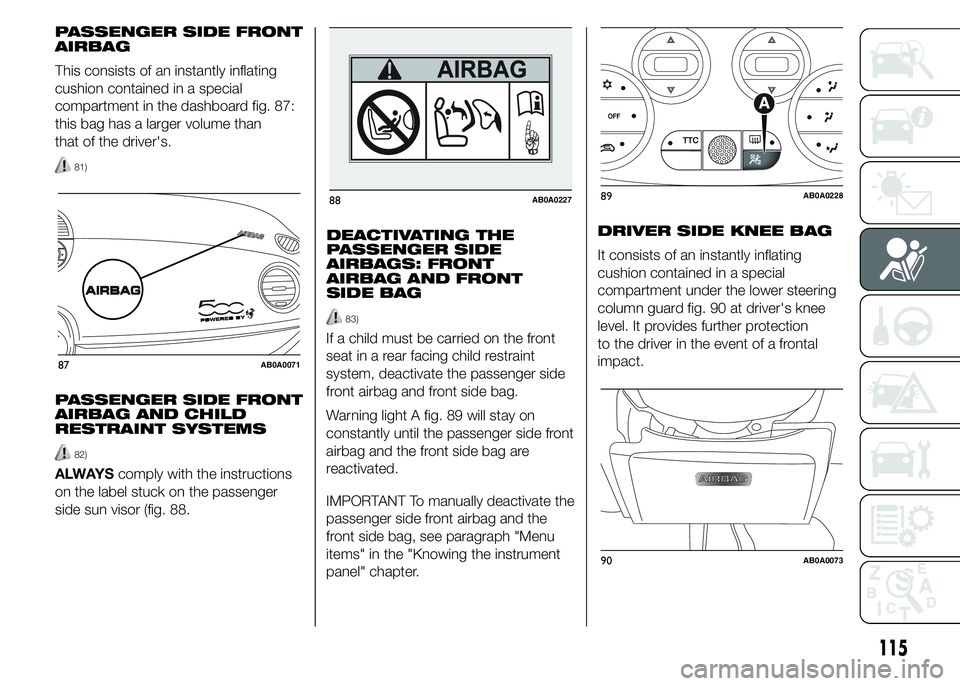
PASSENGER SIDE FRONT
AIRBAG
This consists of an instantly inflating
cushion contained in a special
compartment in the dashboard fig. 87:
this bag has a larger volume than
that of the driver's.
81)
PASSENGER SIDE FRONT
AIRBAG AND CHILD
RESTRAINT SYSTEMS
82)
ALWAYScomply with the instructions
on the label stuck on the passenger
side sun visor (fig. 88.DEACTIVATING THE
PASSENGER SIDE
AIRBAGS: FRONT
AIRBAG AND FRONT
SIDE BAG
83)
If a child must be carried on the front
seat in a rear facing child restraint
system, deactivate the passenger side
front airbag and front side bag.
Warning light A fig. 89 will stay on
constantly until the passenger side front
airbag and the front side bag are
reactivated.
IMPORTANT To manually deactivate the
passenger side front airbag and the
front side bag, see paragraph "Menu
items" in the "Knowing the instrument
panel" chapter.DRIVER SIDE KNEE BAG
It consists of an instantly inflating
cushion contained in a special
compartment under the lower steering
column guard fig. 90 at driver's knee
level. It provides further protection
to the driver in the event of a frontal
impact.
87AB0A0071
88AB0A022789AB0A0228
90AB0A0073
115